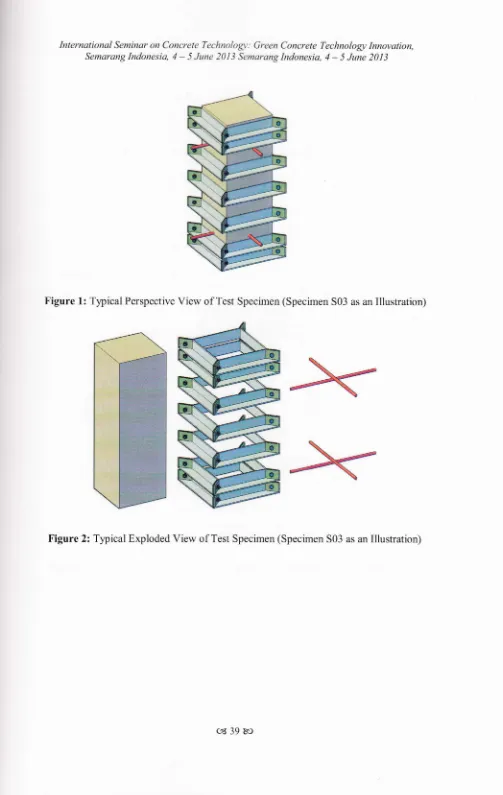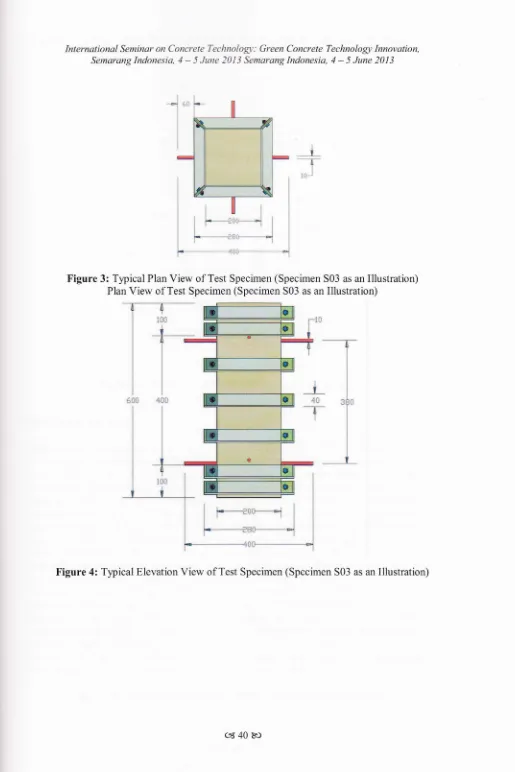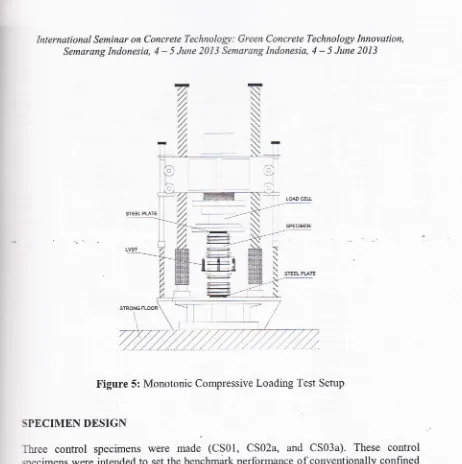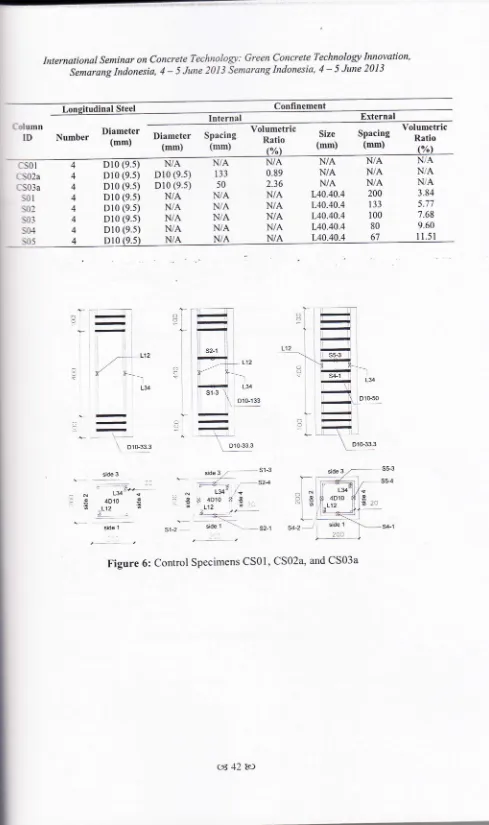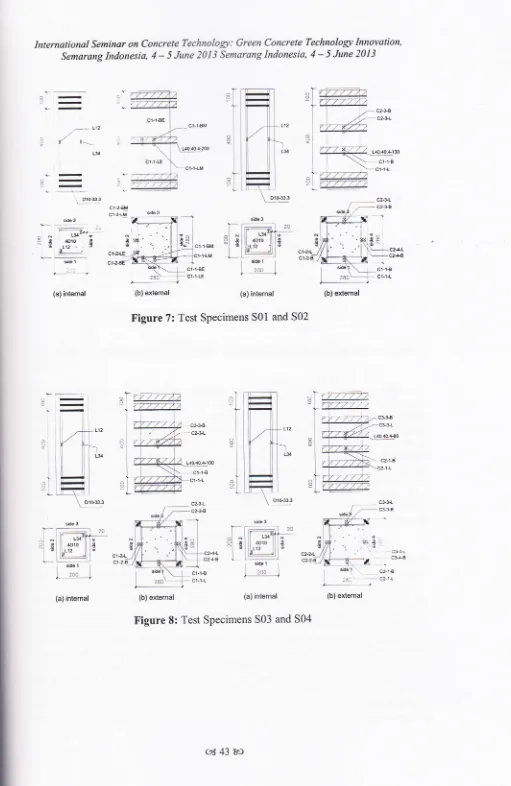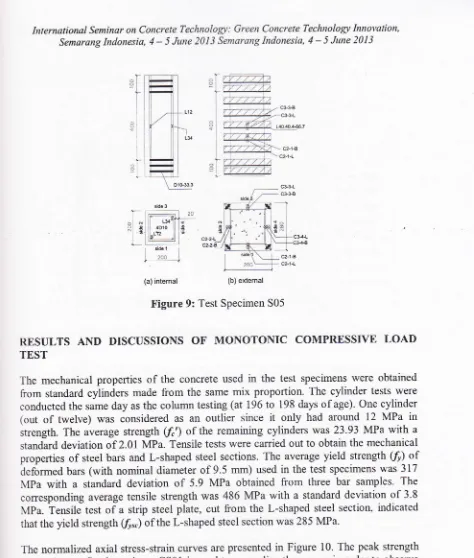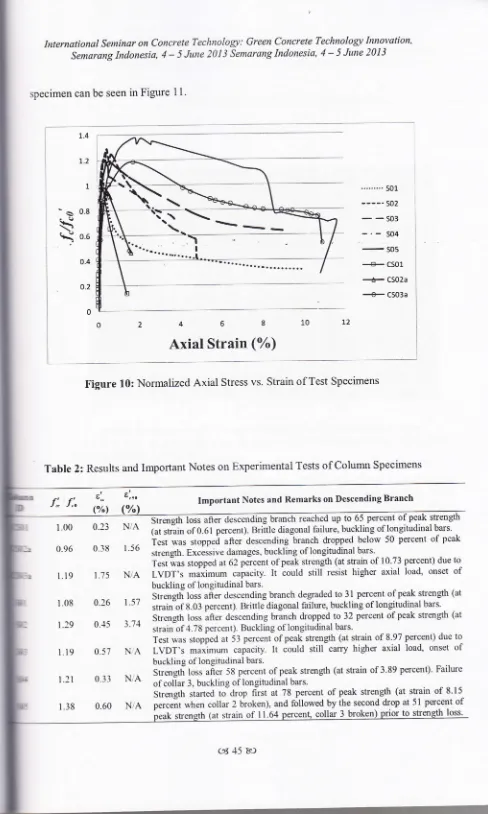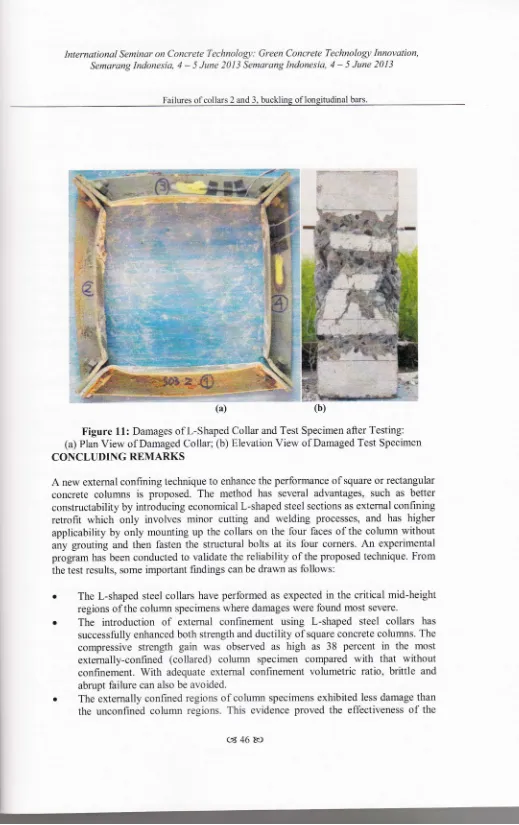PROCEEDINGS
International
Seminar 0rr Concrete
Technology
$mfft
8$x$Rfft
ItGIIt0tE$Y
xHt$xefi$m
fl*
S,OtbOW
Nahl;A
0f Dt4)tlLt4wy
Un;$t/rW
r:::::.i::.€**:=i .:F-,---::
FtrULTY
OS
**
**
::li-li:::.::::,
-:::r::Sa:*:,:
$xx€*ts€T
International Seminar on Concrete Technologt: Green Concrete Technology Innovation,
Semarang Indonesis, 4
-
5 June 2013 Semarang Indonesia, 4-
5 June 2013COMMITTEE
Scientific Commiffee
Dr.
Ir.
Sri Tudjono,MS. (Diponegoro University, hdonesia)Dr. Ir. Tavio, MT. (Sepuluh November Institute of Techrtologt, Indonesia) Dr. Rr. M.I. Retno Susilorini (soegijapranata Catholic University, Indonesia) Dr. Ir. Antonius, MT. (Sultan Agung Islamic University, Indonesia)
Dr
L.ado Riannevo Chandra, ST. (National University of Singapore, Singapore)Honorable Committee
Prof. Sudharto P. Hadi, MES, PttD. (Rector of Diponegoro University)
Prof, Dr. dr. Hertanto Wahyu Subagio, MS. Sp.GK. (Vice Rector
for
Academic Affairs)Dr. Mochammad Chabachib, M,Si. (Vice Rector.for Financial Af.fairs)
Ir. H. Bambang Pudjianto, MT. (Dean of Faculty of Engineering) Dr. rer. nat. Imam Buchori, ST. (Vice Deanfor Academic Affairs)
Ir. M. Agung Wibowo., MM., MSc., PhD. (Yice Deanfor Financial Affairs\
Prof.
Dr. Ir.
Anita
Firmanti, }r4T. (the Research Instituteof
Huntan Settlement, theMinistry of Public Works)
Organizing
Committee
Dr.
Ir.
Sri Tudjono, MS. (Chairman)Ir. Tavio, MS., PhD. (Vice Chairman)
Ir. Purwanto, MT., M.Eng. (Secretary)
Priyo Nugroho, ST., M.Eng. (Secretary)
Aniek Endraiti, ST., MT.
Dwinita Fibriani Astuti, ST.
Guswandi S.Sos.
Sofiyan, A.Md.
Yulita Arni Priastiwi,ST., MT.
Ratih Sukmawati, ST.
Lasino St Apu
Ir.
Sutadji Yuwasdiki, Dipl.E.Eng. Rudi Setiadji, ST., MT.Ir. Agus Sarwono
Cecep Bachery, Dipl.E.Eng.
Dra. Yulinda Rosa, M.Si.
Ir. Han Ay Lie, M.Eng.
Ir.
Arif
Hidayat, CES., MT.Ir. Moga Narayudha, Sp1.
Ir.
YI.
Wicaksono, MS. Indro Tri Nugroho, ST.Ir. Sri Sangkawati, MS.
Dr-
Ir.
Suharyanto, M.ScDr. Ir. Antonius, MT.
Dr.Ir.
Rr. M.I. Retno Susilorini, MT"Jeudi PutriPratiwi, ST., M.Sc
Ir. Hary Budieny, MT. Ir. Drvi Kurniani, MS.
Ir. Frida Kistiani, MT.
Dr. Bagus Hario Setiadji. ST. MT"
Dr.Eng. Sukamta, ST., MT.
Ir. Parang Sabdono, M.Eng.
Adang Triana
Ir. Rudy Yuniarto, MT.
Sujarw-o
International seminar on concrete Technorogt: Green Concrete Technorogl,, Innovation,
semarang Indonesia, 4
-
5 June 20r3 iemarang Indonesio, 4-
5 June 20r3TABLE
OF
CONTENT
Scientific Papers
Innovative Use of FRPfor Sustainable precast Concrete
Structures
... ISami
RIZKALLA
(North Carolina State University, USA)Concrete Durability
In
TropicalClimate...
... 16TAM Chat Tim (National University of Singapore, Singapore)
Strstainable Construction and Microwave Beneficiation to Improve the yield and
Qttality of Recycled
Aggregates
...27
5- c-
G. ong, A. Akbarnezhad,M.H.
zhang,c.
T. Tam (National universityof
Singapore), T. W. J. Foo (Ngee Ann polyteihnic, Singaplre)L-shaped steel collars: An Alteruative External confining Retrofitfor Improving
Ductility and Strength of Rectangular Concrete
Coluruns.l...
... 36 Tavio' P. Pudjisuryadi, and p. Suprobo (Sepuluh November Instituteof
Technology, Indonesia)
Designedfor Disassembly systemfor sustainabre precast construction ...5i
Lado Riannevo GHANDRA, Khim chye GaryoNG,
Ali
AKBARNEZHAD, TAM Chat Tim (National University of Singapore, Singapore)virtttous concrete, concrete Technologt Innovation.for carbon Footprint
Reductiott..
...62 Rr. M. I. Retno Susilorini (Soegijapranata catholic university, Indonesia)
Flyslab Snnrt Solutionsfor Multistorey
Buildings....
... 69 Sulistyana (PT. Kinarya Beton Indonesia, Indonesia)Tlte Interaction of the Constitutive parts of
Concrete...
...75 Muhammad Sahari Besari (Institut Teknoiogi Bandung)
Sponsorship Thank
you
page
... gghternational Seminar on Concrete Technologt: Green Concrete Technology Innovqtion, semarang Indonesia, 4
-
5 hme 2013 Semarang Indonesia, 4-
5 June 2013L.SHAPED STEEL COLLARS:
AN
ALTERNATIVE
EXTERNAL
CONFINING
RETROFIT
FOR
I}IPROVING
DUCTILITY
AND STRENGTH
OF
RECTANGULAR
CONCRETE COLUMNS
Tavio, P. Pudjisuryadi, and P. Suprobo
Department of Civil Engineering
Sepuluh November Institute of Technology
Surabaya, Indonesia
-Email: tavio@ce. its. ac. id
ABSTRACT
l;nfurement
in
concrete column has beenwell
knownto
improveits
strength and:':ctility.
Such enhancement is primarilv essential when needed to improve the bihavior-: concrete columns particularly in terms of ductility during the earthquake strike. This
r;r'antage is in line with the modern concept of moment-resisting frame which requires
:-ictile structural framing members.
Up to
present, traditional transverse steelis still
led
as
internal
confinementin
concrete column. Several researches have been:::ducted
extensivelyto
study the behavior of confined column, both analytically and: tperimentally.
All
these studies confirmed that internal confining method significantly::rroves
the strength andductility
of
the columns. However, sometimes the existing: -
lumns
in a
building
do not
satisfii
the
building code
requirements either-::rntentionally or due to the unawareness
of
seismic hazards in termsof
confinement.-:ce
the column is built and cast, there is nowayto
revise the lack of transverse steel:::ernally' The only way possible is
to
retrofit the columns by using external means.--:-gh demand of strengthening on existing RC buildings has made external confinement :'c-:oming increasingly popular as
an
altemative external confiningretrofit for
RC: - -umns. Various types
of
external confinement have been introducedto
increase the;tength
andductility
of
the
columns, such asFRp
wrapor
even the useof
steel:":keting. These extemal confining techniques have been proven
to
be successful in:::ofitting
circular concrete columns. Experimental programs aswell
as confining:rldels
for
externally confinedcircular
columns have beenwell
developed.It
is,l:'*'ever,
still
uneasyto
provide an effective confining stressby
externalietrofit
on i{ -lare or rectangular concrete column. The non-uniform confining stress on column is::e
to
high
stress concentrationat
column comers.Only a few
experimental and:::l}tical
studies addressed these issues.The most recent proposed external confinement-:thod
is
by
using
the
steelcollars
with
hollow
square section.This kind of
:::finement
method has been provento
work well
as confining systemfor
concrete:: iumns. The strength and particularly the ductility of the columni have been improved
,
-:mficantly. However,
it
is still too hear,y and uneconomical for use as column retrofit. l:-e needof
light and economic types of external confining rr-rrofir is urgentlyrequired:
the country like Indonesia. Thus, an external confining merhod that is utilizing light--shape steel section is studied for its capability as an alternatir.e retrofit for rectangular
::
square concrete columns.This
paperis
a part
of
the first
phaseof
a
multiyearInternational Seminar on Concrete Technologt: Green Concrete Technologt Innovation,
semarang Indonesia, 4
-
5 June 2013 semarqng Indonesia, 4-
5Juie
2013research project carried out by the authors. In this paper, a proposed alternative external
rytrofit for improving the ductility and strength of square concrete columns is presented.
Eight columns specimens were cast and tested under monotonic compressive loading.
A
set
of
L-shaped steel collars have been introduced extemallyon
square concrete"'olumns
prior
to
testing.The
results have confirmedthat
th"
p.opored external '-onfining techniques considerably enhanced the compressive strength and ductilityof
the column specimens.
Keywords:
Compressive strength,Ductility,
External confinement, Retrofit, Square:oncrete columns, Steel collars, Stress-strain curves.
NTRODUCTION
l:e
confinement conventionally providedby
traditional transverse reinforcement has :ee'n well known to significantly enhance the strength and ductility of RC columnsIl-'r-- ManY analytical and experimental studies conducted
to
inveitigate the effectsof
:'afinement can
be
found
in
literatures[-30].
Those researchescover
circular,-::tangular, and square column sections. The loadings on the
specimens include axial
a,::l combined
axial
and bendingin
monotonic andcyclic
patterns.It
is
generally:::cluded
that the
affecting variablesof
confined concrete behavior arethe
plain :r::crete compressive strength, volumetric ratioof
confinement steelto
concrete iore,' -rtrd strength of confining reinforcement, ratio of area
of
longitudinal steel around the:,:':e perimeter and"the resulting tie configuration, and tie spacing. General agreements
:l
the improved stress-strain relationshipof
confured concrete are the incrementof
::rpressive
strength, flatter.,post-peak descending branchof
the curve, and increment::
.rltimate compressive strain (increment of ductility).:'*ides
the conventional confinement studies, recent research are extended to external:::rfinement approach
[5-8].
It
is
essentialto
develop such approach dueto
high:enalds on
concrete columns retrofits.Early
studiesprimarily
dealwith
circular:::crete
column retrofits. This kind of retrofits has been proven by experimentsto
be:r-;cessful. The most recent proposed external confinement method is by using the steel
: : -lars with hollow square section. This confinement method has been proven to work
;*:-l
as
confining systemfor
concrete columns.The
strength and particularly the:-rctility of the columns have been improved significantly. Horvever,
it
is still too heavy;,:-d uneconomical for use as column retrofit. The need
of
light and economic typesof
''':ternal confining retrofit is urgently required in the country like Indonesia. Thus, an =Eternal confining method that is
utilizing
light L-shape sreel section is studiedfor
its:'.pability as an
alternativeretrofit
for
rectangularor
square concrete columns.I--I,r'ever,
for
rectangular and square columns, predicting effective confining stress by":ternal
retrofit is not a
simple task. Similarto
internal confinement, the confiningi::ess in this sectional shapes, is not uniform due to stress concentration in the corners.
lrme
experimental and only a few analytical studies are found to address this problems-r-11]. The complexity
of
external confinement includes failure mechanism. contact:ehavior between concrete and external confinement elements, and distribution
of
: rnfining stress
in
3D
space, which can be totally different to thoseof
conventional,::mrpS.
International Seminar on Concrete Technologt: Green Concrete Technologv- Innovation, Semarang Indonesia, 4
-
5 June 2013 Semarang Indonesia, 4-
5 June 2013.iis
paper is a part of the first phaseof
a multiyear research project conducted by the.ii:hors.
Eight
columns specimens were cast and tested under monotonic concentric:: rnpressive loading.
A
set of L-shaped steel collars have been introduced externally oniq'-tare concrete columns
prior
to
testing.The
experimentalrvork
confirmed the:crformance of square columns considerably improved by the introduction of this type
:
f
external confinement. The results obtained from the experimental test included thei.rial stress-strain curves as
well
as the damage patterns.It
confirmed that the proposed'rrernal
confining techniques considerably enhancedthe
compressive strength and:-rctility
of
the
column specimens.The
researchmainly
aimsto
providea
better -:derstandingof
the impactof
external steel collar confinement on the behaviorof
:r-,rcrete columns.
L\PERIMENTAL
SETUPThe
strengthand ductility
enhancementof
concrete:,: lumns retrofitted by external steel collars was investigated in the study. The proposed
reel
section usedas
an
altemative external confiningretrofit on
square concrete;,:,lumns was that commonly available in the market and economical, i.e. the L-shaped
't;el
section. The sectional dimensions were L40.40.4. The external confinement was::.rlemented on the column specimen by mounting up the L-sections on its four faces
"
rh
uniform spacing and then fastened the structural boltsat
its
four
corners. The:.pical
perspective illustrationof
the
assembled and explodedviews
of
a
typical ;recimen can be seenin
Figures1
and 2. The column sizes were 600 mm high with--,r1x200 mm2 square cross section. Both 100-mm bottom and top ends of the column
'recimens were
heavily
confinedthat
no
damagewas
expectedin
these non-test ::gions. The 400-mm mid-test region was confinedwith
various numbersof
external.;:el
collars.A
set of rods were also installed within the test regions defining the gauge;:gths on each face
of
the column specimens. Plan and elevation views of the typical ,;:ecimens are depictedin
Figures3
and4.
The specimens were then tested under-onotonic concentric compressive loading as shown in ::,:ure 5.
International Seminar on Concrete Technology: Green Concrete Technology Innovation,
Semarang Indonesia, 4
-
5 June 2013 Semarang Indonesia, 4-
5 June 2013Figure 1: Typical Perspective View of Test Specimen (Specimen S03 as an Illustration)
Figure 2: Typical Exploded View of Test Specimen (Specimen S03 as an Illustration)
International Seminar on Concrete Technologt: Green Concrete Technologlt Innovation,
Semarang Indonesia, 4
-
5 June 20 I 3 Semarang Indonesia, 4-
5 June 20 I 3__L
*"T*
I r,J
oi'*j
rl
i$ffi
,l
l+-*****---+i
Figure 3: Typical Plan View of Test Specimen (Specimen S03 as an Illustration)
Plan View of Test Specimen (Specimen S03 as an Illustration)
Y
Figure 4: Typical Elevation View of Test Specimen (Specimen S03 as an Illustration)
International Seminar on Concrete Technologi: Green Concrete Technologt Innovation,
Semarang Indonesis, 4
-
5 June 2013 Semarang Indonesia, 4-
5 June 2013\\
\
\-\
STEEL PUTE
/--/_
Figure 5: Monotonic Compressive Loading Test Setup
SPECIMBN DESIGN
Three
control
specimenswere
*uA.
(CSOI, CS02a,and
CS03a). These controlspecimens were intended to set the benchmark performance of conventionally confined
column
specimensunder
compressiveload.
CS01was
constructedwithout
any confinementwithin
the test region; CS02a was designedto
represent the conditionof
columns confinedwith
gravity confinement requirement; and CS03a was designed to represent the conditionof
columns confinedwith
seismic confinement requirement. Five collared specimens (S01, S02, S03. S04, and S05) were built to study the impactoi
proposed confinement technique on concrete columns. S01 u'as the specimen with thelowest volumetric ratio of confinement collars (with one collar in the mid-test region), rvhile S05 was the highest (five collars in the mid-test region). The volumetric ratio set
for these five specimens, namely S01, S02, S03, S04, and S05, were 3.84, 5.77,7.68,
9.60, and 1 1.51 percent, respectively. The volumetric ratio is defined as the volume of a
collar with respect to the volume
of
column determined from the gross cross-sectionalarea of the column multiplied by the spacing of collars u'ithin the mid-test region. Table
1 summarizes the details of reinforcement and confinement of the test specimens. The
specimens
were
equippedwith
ser-eralstrain
gaugesto
take
the
deformationmeasurement of concrete and steel as shou-n in Figures 6 to 9. These fi-gures also shorv
the configuration of external steel collars on column specimens S0l to
S05-Table 1: Details of Test Specimen's Reinforcement and Confinement
@-.o-"...
.TEELPLATE ,
---\\\\
V_=--______ \ -{ecru;r
I
International Seminar on Concrete Technologt: Green Concrete Technologt Innovation' semarang Indonesia, 4
-
5 June 2013 Semarang Indonesia, 4-
5 June 2013Column
ID Number Diameter(mm) Diameter (mm)
Spacing
(mm)
Volumetric
Ratio Spacing(mm)
Volumetric Ratio Size (mm) /o CSOI CS02a lS03a s0l s02 s03 so4 s05 N/A 0.89 2.36 N/A N/A N/A N/A N/A N/A N/A N/A L40.40.4 L40.40.4 L40.40.4 L40.40.4 L40.40.4 N/A N/A N/A 3.84 5.77 't.68 9.60
t l.5l
4 4 4 4 4 4 4 4
Dl0 (9.s)
Dl0 (9.5) D10 (9.s)
Dl0 (e.5)
Dlo (e.5)
Dlo (9.5)
Dlo (e.5)
N/A
Dlo (e.5)
Dlo (e.5)
N/A N/A NiA N/A N/A N/A 133 50 N/A N/A N/A N/A NiA NiA N/A N/A 200 133 100 80 67
Dlo (9.5
-l
=l
+
I ol:
-l--l
,/
-:: :L12{x-...
L34
- l,
l:--\
o,q.t. side 3-L9sN
€ 4D1o €
=3 a L12
J-.
side 1
-1-2
\
\__
oto-ss.aside 3 /--, s1-3
-...7: S2-4
'
L34K'o
s4Diogg^-' t12 6 t'
11+
r--side 1 -':--- S2-1 54
'.: ,
C C
i,
LI
Figure 6: Control Specimens CSOI, CS02a, and CS03a
ff;
-r,z
Y/
B....-lr--l
4 L34
s1-3 \\
oro-rgg
International Seminar on Concrete Technologt: Green Concrete Technologt Innovqtion,
Semarang Indonesia, 4
-
5 June 2013 semarang Indonesia, 4-
5 June 2013-*_ L12 x/k Lg s&3 -&-= € aL12-4oro !
Sel aaa (a) intemal
:el
e&1 a- . DlG3.3
=l
r
t'
.t c1-1-LM 2ea c1-1-BE c1-1-LE(b) extemal (a) intemal
Figure 7: Test Specimens S01 and S02
(b) external (a) internal
Figure 8: Test Specimens S03 and S04
(b) external
-frfzzz-z
- Lr-t 7
r-/7-=l
I L 3l _Lrr-'.-7..=:
rffi,.:;,
rW
-T---=<F-7'tr 7 7 7ZA-..r',u
T-_r
ay ..-c2-r{7
7/7'
aT7
-.,
side 3
T- r=-l F-- m:-2a - ^i 134- r i:€lt4D10l€6L1216
$ Jl I
l -t
sids I
)a.
L -(a) internalr
l"
t c2-lLf _- c2_a
hiernationol Seminar on Concrete Technologt: Green Concrete Technologt Innovation,
Semarang Indonesia, 4
-
5 June 2013 Semarqng Indonesia, 4-
5 June 2013ET
r
t
=l
side 3
- .-:l r:+*fff* )a
P e ' 6l Lt2 I 4D1o lli€a l$ .l
!l
side 1
tt )ao I
-(a) internal
Figure 9: Test Specimen S05
RESULTS
AND
DISCUSSIONSOF
MONOTONIC
COMPRESSIVE LOAD
TEST
The mechanical properties
of
the concrete usedin
the test specimens were obtainedfrom standard cylinders made from the same
mix
proportion. The cylinder tests wereconducted the same day as the column testing (at 196
to
198 days of age). One cylinder(out
of
twelve) was considered as anoutlier
sinceit
only
had around 12MPa
in strength. The average strength(f"')
of the remaining cylinders was 23.93 MPawith
astandard deviation of 2.01MPa. Tensile tests were carried out to obtain the mechanical
propefiies
of
steel bars and L-shaped steel sections. The average yield strength fifi)of
deformed bars (with nominal diameterof
9.5 mm) used in the test specimens was 317Mpa
with a
standard deviationof
5.9MPa
obtainedfrom
threebar
samples. The corresponding ayerage tensile strength was 486 MPawith
a standard deviationof
3-8MPa. Tensile test
of
a strip steel plate, cut from the L-shaped steel section, indicatedthat the yield strength(fy,,) of the L-shaped steel section was 285 MPa.
The normalized axial stress-strain curves are presented in Figure 10. The peak strength
Ga,) of unconfined specimen CS01 is used to normalize the curves in order to observe the effect of confinement on column strength gain.
It
can be seen from the figure that CS01 and CS02a exhibitedvery brittle
and abrupt behaviors.The
strengthsof
the columns decreasedrapidly
after reachingthe
peak stress.S0l
demonstrated rathersimilar behavior to the former
two
specimens except thatit
performed a delay'ed post-peak ductility response. CS03a indicated good ductility asit
finally
lost the strength atipproximately 10 percent
of
strain. S02 showed a strength gain comparable to CS03aUut
it
aiteA to mimic its ductility. S03 depicted almost similar behavior to CS03a. S04did not express the expected result since one
of
the collars suffered early failure. Thestrength guir,
*us
evident, butit
evinced relatively poor ductility. S05 performed best,.rrft
of all, asit
gained the highest strength so as the ductility. Important stages of thetests are summarized in Table 2. The typical damage
of
the steel collars and concreteInternationql Seminar on Concrete Technology: Green Concrete Technologt Innovution, semarang Indonesia, 4
-
5 June 2013 Semarang Indonesia, 4-
5 June 2013specimen can be seen in Figure 1 1.
1.4
t.2
, -s
0.8.L)
\
H
o.uo.4
0.2
...'...s01
---
s02--s03
-'-
s04-
s05
+t-
CS01+
602a*C503a
Important Notes and Remarks on Descending Branch
p....i,
*ten collar 2 bioken), and followed by the second drop at 51 percent of neek strenoth (at strain of 11.64 Dercent, collar 3 broken) prior to strength loss.468
Axial
Strain
(%o)
Figure 10: Normalized Axial Stress vs. strain of Test Specimens
Table 2: Results and Important Notes on Experimental Tests of Column Specimens
f:
f:"
1.00 0.96 1.19 1.08 1.29
l.l9
l.2l 1.38 € (%\ 0.23 A0.38
1.561.75
N/A0.26
r.570.,15
3.710.51
N,',A0.3i
NiA0.60
NIA t'.,.w
N/A ched up to 65 percent ofpeak
strength
1at strlin of 0.61 percent). Brittle diagonal failure, buckling of longitudinal bars.
Test uas ,topp"d after descending branch dropped below 50 percent of peak strength. Excessive damages, buckling of longitudinal bars'
Test ir.as stopped at 62 percent ofpeak strength (at strain of 10.73 percent) due to
LVDT,s maximum capacity.
It
could still resist higher axial load, onset ofbuckling of longitudinal bars.
Strength'loss after descending branch degraded to 31 percent ofpeak strength (at
strainof 8.03 percent). Brittle diagonal failure, buckling of longitudinal bars. Strength loss after descending branch dropped to 32 percent of peak strength (at strain of 4.78 percent). Buckling of longitudinal bars.
Test was stopped at 53 percent ofpeak strength (at strain of8.97 percent) due to
LVDT's **in1urn capacity.
It
could still carry higher axial load, onset ofbuckling of longitudrnal bars.
Strengtiloss after 58 percent of peak strength (at strain of 3.89 percent). Failure
ofcollar 3, buckling of longitudinal bars.
Strength started to drop first at 78 percent ofpeak strength (at strain of8.l5
International Seminar on Concrete Technologt: Green Concrete Technologt Innovation,
Semarang Indonesia, 4
-
5 June 2013 Semarang Indonesia, 4-
5 June 2013Failures ofcollars 2 and 3, buckling oflongitudinal bars.
(b)
Figure 11: Damages of L-shaped Collar and Test Specimen after Testing:
(a) plan
view
of Damaged collar; (b) Elevationview
of Damaged Test SpecimenCONCLUDING REMARKS
A new external confining technique to enhance the performance ofsquare or rectangular
concrete columns
is
proposed. The method has several advantages, such as betterconstructability by introducing economical L-shaped steel sections as external confining
retrofit which
only
involves minor cutting and welding processes, and has higher applicability by only mounting up the collars on the four faces of the column without any grouting and then fasten the structural bolts at its four corners.An
experimentalprogram has been conducted to validate the reliability ofthe proposed technique. From
the test results, some important findings can be drawn as follows:
r
The L-shaped steel collars have performed as expected in the critical mid-heightregions of the column specimens where damages were found most severe.
o
The
introductionof
external confinementusing
L-shaped steel collars hassuccessfully enhanced both strength and ductility of square concrete columns. The
compressive strength gain was observed as
high
as38
percentin
the mostexternally-confined (collared) column specimen compared
with
that
without confinement.With
adequate external confinement volumetric ratio,brittle
andabrupt failure can also be avoided.
.
The externally confined regions of column specimens exhibited less damage thanthe unconfined column regions. This evidence proved the effectiveness
of
thehternaional Seminar on Concrete Technologlt: Green Concrete Technologt lrtnovation,
Setnarang Indonesia, 4
-
5 June 2013 Semarang Indonesia, 4-
5 June 2013proposed external confinement technique. The severely damaged collars after the
completiron
of
the tests have indicated that the applicationof
grouting betweencollars and column faces is no longer required in the post-peak nonlinear inelastic
response since the passive confinement
will
have afull
contact with column faces,and thus fully work atlarge lateral column deformation.
FUTT'RE RESEARCH
The research presented herein is from the
frst
phaseof
the multiyear research projectconducted by the authors. In the
frst
phase, the resultsof
the experimental works arereported. Subsequent experimental pqograr4s in the next phases are currently designed
to further investigate the fea:sibility of theproiosed technique.
A
setof
six speciienswith various enhancements from the basic technique is prepared. Two specimens
will
bebuilt
to
studythe
effectivenessof
the
proposed method when combinedwith
thetraditional internal confinement. The remaining
four
specimens have L-shaped steelcollars modified by additional web stiffeners and dynabolts to enhance the stiffness
of
the
collars. Furthermore,five
column specimens(two
control specimens and threecollared specimens)
will
also be prepared to examine the performance of the proposedtechnique under cyclic lateral loading.
ACKNOWLEDGEMENTS
The
frst
phaseof this
multiyear research project,which
included an experimental program, has been carried out in the Structural Laboratory at Centerof
Research andSettlement Development,
Ministry
of
Publicworks,
Bandung. The authors$eatly
acknowledge for all the support received.REFERENCES
Sheikh,
S.
A.,
(1982),A
Comparative Studyon
Confinement Models,ACI
Journal,y.79,
No. 4, American Concrete Institute, Farmington Hills, Michigan, USA, pp. 296-306.Mander, J. B., Priestley,
M.
J. N., and Park, R., (1988), Theoretical Stress-StrainModel for Confined Concrete, Journal of Structural Engineering. ASCE,
V.
I 14,No.
8, American Societyof Civil
Engineers, Reston, Virginia. USA.pp.
1824-1826.Mander, J.
B.,
Priestley,M.
J.N.,
and Park, R., (1988), Observed Stress-StrainBehavior
of
confined concrete," Joumalof
structural Engineerirrg. ASCE,v.
114,
No.
8 ,
American Societyof Civil
Engineers, Reston, Virginia. USA, pp.1827-1849.
Saatcioglu,
M.,
and Razvi, S.R.,
(1992), Strength andDuctility
of
Confined Concrete, Journalof
Structural Engineering, ASCE,V.
I 18, No-6,
American Society ofCivil
Engineers, Reston, Virginia, USA, pp. 1590-1607.Chai, Y. H., Priestley, M. J. N., and Seible, F., (1994), Analytical Model for
Steel-Jacketed RC Circular Bridge Columns, Journal o.f Structural Engineering, ASCE,
y.
120,No.
8, American Societyof Civil
Engineers, Reston, Virginia. USA, pp.2358-2376.
tll
121
t3l
l4l
lsl
International Seminar on Concrete Technology: Green Concrete Technologt Innovation, semarang Indonesia, 4
-
5 June 2013 semarang htdonesia, 4-
5 June 2013t6]
Saafi,M.,
Toutanji,H. A.,
andLi,
2.,
(1999), Behaviorof
concrete columns Confinedwith
Fiber-Reinforced Polymer Tubes,ACI
Material Journal,V.
96,No. 4, American concrete Institute, Farmington
Hills,
Michigan, USA, pp.500-
509-l7)
Fanr,A.
2.,
and Rizkalla, S. H., (2001), Confinement Model forAxially
Loaded Concrete Confined by Circular Fiber-Reinforced Polymer Tubes, ACI Sfiuctural Journal,V.
98, No. 4, American Concrete Institute, Farmington Hills, Michigan, USA" pp. 541-461.tgl
Carey,S.
A.,
and Harries,K. A.,
(2005),Axial
Behavior and Modelingof
Confined Small-, Medium-, and Large-Scale Circular Sections with Carbon Fiber-Reinforced Polymer Jackets,
ACI
Structural Journal,V.
102,No. 4,
AmericanConcrete Institute, Farmington Hills, Michigan, USA, pp' 596-604'
t9]
Xiao,Y.,
and Wu,H.,
(2-003), Retrofitof
R.irfo..ed
Concrete Columns usingpartially Stiffened Steel Jackets, Journal
of
Structural Engineering, ASCE,V-129, No. 6, American Society of
Civil
Engineers, Reston, Virginia, USA, pp. 725-732.[10]
Hussain, M. A.; and Driver, R. G., (2005), Experimentat Investigation of External Confinementof
Reinforced Concrete Columnsby Hollow
Structural Section Collars,ACI
StructuralJountal,
Y.
102,No. 2,
American Concrete Institute, Farmington Hills, Michigan, USA,pp.242'251-Il]
Lee, C. S., Hegemier,G.A.,
and Phillippi,D.
J., (2010),Analyical
Model forFiber-Reinforced Polymer-Jacketed
Square Concrete
Columns
in
Axial
Compression,
ACI
Structural Journal,
Y.
107,
No.
2,
American Concrete Institute, Farmington Hills, Michigan, USA, pp.208'217 'll1)
Tabsh, S. W., (iOOl), Stress-Strain Model for High-Strength Concrete Confinedby Welded Wire Fabric , Jortnrul of Materials in Civil Engineering, ASCE,
V.
19'No. 4, American Society of ci-yil Engineers, Reston, virginia, uSA, pp. 286-294.
tl3]
Hoshikusuma, J., Kawashima, K., Nagaya, K., and Taylgr,A.
w.,
(1997),Stress-Strain
Model
for
Confined Reinforced Concretein
Brigde. Piers,Jountal
of
Structural Engineering,
ASCE,
V.
123,No. 5,
American Societyof
Civil
Engineers, Reston, Virginia, USA, pp. 624-633'
t14l
RaJvi, S. and Saatcioglu,M.,
(1999), Confinement Modelfor
High
Strength concrete, Journalof
structural Engineerirag, ASCE,V.
125,No.
3, American Society ofCivil
Engineers, Reston, Virginia, USA, pp' 281'289'tl5]
Kusuma,B.,
and
Tavio,
(2008),Unified
Stress-StrainModel
for
ConfinedColumns
of Any
Concrete and Steel Strengths, Thel"
Intenrational Conference on Eafihquake Engineering and Disaster Mitigation, Jakarta. Indonesia, pp.502-s09.
t16]
Kusuma, B., and Tavio, (2009),A
Comparative Study of Models for Confinementof
Concreteby
Welded
Wire
Mesh,
The
l"
Intemational
ConferenceRehabilitation and Maintenance
in
Civil Engineering(lCkt'tCE),
Sebelas Maret University, Solo, Indonesia, pp. 90-101.ll7)
Kusuma,B.,
Tavio, and Suprobo, P., (2011),Axial
Load Behaviorof
ConcreteColumns
with
WeldedWire
Fabrics as Transverse Reinforcement- The TwelfthEast Asia-Pacffic Conference on Structural Engineering
&
Constntction(EASEC-12), Hong
Kong
convention and Exhibition center, Hong Kong,
ProcediaEngineering, Elsevier Ltd',
V.
14, Paper No' 256, pp' 2039-2041'U8]
Kusuma,B.,
Tavio, and
Suprobo,P.,
(2011), Pred.ictionof
Peak Stress for Concrete Confinedwith
WeldedWire
Fabric, The 2"0 Intentational ConferenceInternational Seminar on Concrete Technology: Green Concrete Technologt Innot ation,
Semarang Indonesia, 4
-
5 June 2013 Semarang Indonesia, 4-
5 hme 2013on Earthquake Engineering and Disaster
Mitigation
(ICEEDM-II), Shan,rri-La Hotel, Surabaya, Indonesia, pp. F- 1 17-F- 13l.
":91
Pudjisuryadi, P., and Tavio, (2013), Compressive Strength Predictionof
SquareConcrete Columns Retrofitted
with
External Steel Collars,"Civil
EngineeingDimension:
Joumal
of
Civil
Engineering Science and Applicalion, ThomsonGalerM, Petra Christian University, Surabaya, Indonesia,
V.
15, No. 1, pp. l8-24..f
0]
Pudjisuryadi P., Tavio, and Suprobo, P., (2011), Transverse Stress Distribution inConcrete Columns
Externally Confined
by
Steel
Angle Collars, The
P
International Conference
on
Earlhquake Engineering and Disaster Mitigation(l CE EDM-II), Shangri-La Hotel, Surabaya, Indonesia, pp. H- I 39-H- I 43.
.f
ll
Pudjisuryadi, P., Tavio, and Suprobo, P., (2013), Analytical Confining Modelof
Square Reinforced Concrete Columns using External Steel Collars, International
Jountal of lCT-aided Architecture and Cinil Enginedring, SERSC.
.f2]
Tavio,
Budiantara,I.N.,
and
Kusuma,
B.,
(2008),
Spline
Nonparametric RegressionAnalysis
of
Stress-StrainCurve
of
Confined
Concrete, CivilEngineering Dimension: Joumal
of
Civil
Engineering Science and Application, Thomson GalerM, Petra Christian University,V.
10,No.
1, Surabaya, Indonesia,pp. 14-27.
.f
3l
Tavio, andKusuma,8.,
(2009), Stress-Strain Model for High-Strength ConcreteConfined
by
WeldedWire
Fabric, Discussion,Journal
of
Materialsin
CivilEngineering, ASCE,
y.
21,No.
1, American Societyof Civil
Engineers, Reston,Virginia, USA, pp. 40-45.
.f4]
Tavio, Kusuma, B., and Suprobo, P., (2012), Experimental Behaviorof
ConcreteColumns Confined
by
WeldedWire
Fabric as Transverse Reinforcement underAxial
Compression,ACI
Structural Joumal,V.
109,No.
3, American ConcreteInstitute, Farmington Hills, Michigan, USA, pp. 339-3a8.
.f
5]
Tavio, Suprobo, P., and Kusuma,8.,
(2007), Effects of Grid Configuration on theStrength and Ductility of HSC Columns Confined with Welded Wire Fabric under
Axial
Loading,"Thel"
Intentational Conference on Modem, Construction and Maintenance of Stntctttres,Y.l,
Hanoi, Vietnam, pp. 178-185..16l
Tavio, Suprobo, P., and Kusuma,B.,
(2008),Ductility
of
Confined ReinforcedConcrete
Columns
with
Welded
ReinforcementGrids, The
IntentationalConference Excellence
in
Concrete Construction-
through Innovation, KingstonUniversity, London,
UI!
pp. 339-344..l7l
Tavio, Suprobo, P., and Kusuma, B., (2008), Strength and Ductility Enhancementof Reinforced HSC Columns Confined with High-Strength Transverse Steel, The
Eley'enth East Asia-Pacific Conference on Stntctural Engineering
&
Construction(E,ISEC-11), Taipei International Convention Center, Taipei, Taiwan,
pp.
350-351.
.18]
Tavio, Suprobo, P., and Kusuma, B., (2011), Investigation of Stress-Strain Modelsfor
Confurementof
Concreteby
WeldedWire
Fabric, The Twelfth East Asia-Pacific Conference on Structural Engineering&
Construction (EASEC-12), HongKong
Convention andExhibition
Center, HongKong,
Procedia Engineering,Elser ier Ltd.,
V.
14. Paper No. 255, pp.2031-2038..f9]
Tario.
and Tata,A.,
(2009), Predicting Nonlinear Behavior and Stress-StrainRelationship
of
RectangularConfined
Reinforced Concrete Columns with ANSYS. Civil Engineering Dimension: Journal of Civil Engineering Science andApplication Thomson Galer\{, Petra Christian University,
V.
11, No. 1, Surabaya,Indonesia, pp.23-31.
International Seminar on Concrete Technologt: Green Concrete Technologtt Innovation,
Semarang Indonesia, 4
-
5 June 2013 Semarang Indonesia, 4-
5 June 2013l30l
Tavio,
Wimbadi,
I.,
Negara,A.
K.,
and Tirtajaya
R.,
(2009), Effects
of
Confinement on Interaction Diagrams
of
Square Reinforced Concrete Columns,Civil
EngineeringDimension:
Journal
of
Civil
Engineeting
Science andApplication, Thomson GalerM, Petra Christian University, Surabaya, Indonesi4
V.
Il,
No. 2, pp. 78-88.